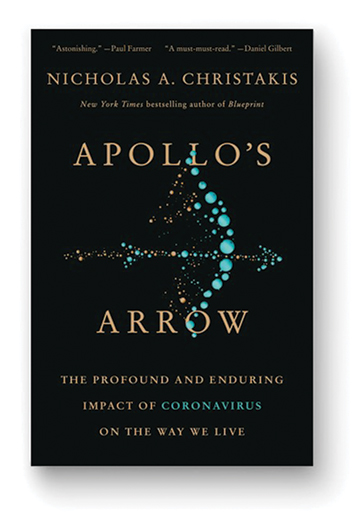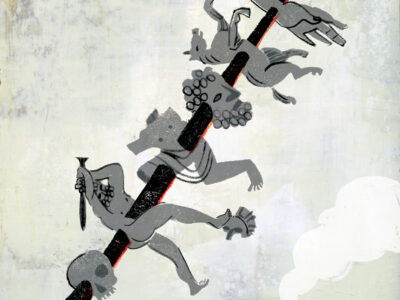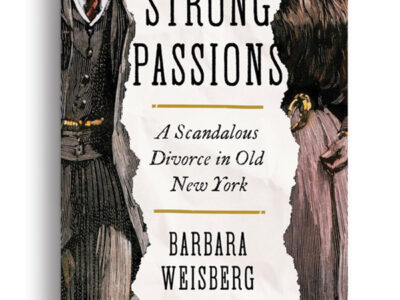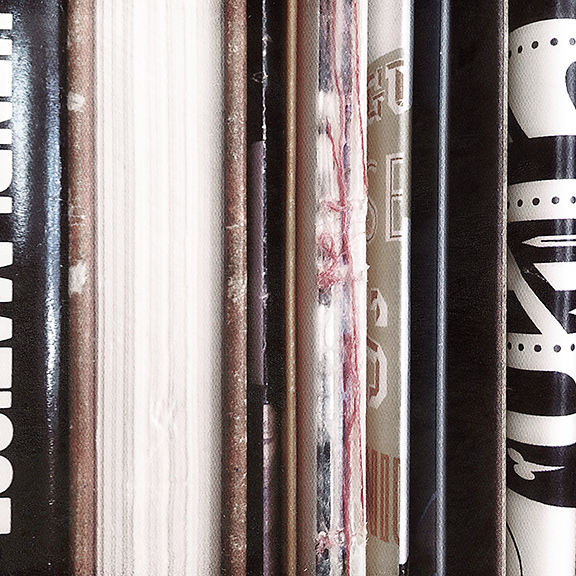Nicholas Christakis speculates on the pandemic’s ultimate social impacts, and finds cause for optimism.
By Julia M. Klein

Apollo’s Arrow: The Profound and Enduring Impact of Coronavirus on the Way We Live
By Nicholas Christakis
Little, Brown Spark, 384 pages, $29
As of late 2020, with COVID-19 again spiking across Europe and the United States, more illness, death, social isolation, and economic devastation seemed inevitably to lie ahead. Several promising vaccines, along with better treatments and public-health measures, may temper that grim forecast. But meanwhile anxiety and dismay registered as natural responses to our repeated missteps in both controlling the pandemic and mitigating its economic and social harms.
Into this winter of our discontent strides the ebullient Nicholas A. Christakis G’92 Gr’95 GM’95 with a book that points us both backward, to plagues past, and forward—with measured optimism—to a post-pandemic world. The most remarkable feature of Apollo’s Arrow: The Profound and Enduring Impact of Coronavirus on the Way We Live is the blazing speed with which it was written—in the midst of a rapidly unfolding event whose course and impacts can’t yet be fully known.
That, of course, is one of the challenges of the book, composedbetween March and August, a period when Americans were not yet being diagnosed at the rate of 175,000 or more cases per day. Christakis’s biggest miss, however, is underestimating the rapidity with which vaccines would be ready for distribution. He predicts in the book that an effective vaccine “might not arrive before we achieve herd immunity” in 2022.
For now, though, Christakis—the Sterling Professor of Social and Natural Science at Yale, where he also serves as director of the Human Nature Lab—may be as well suited as anyone to contextualize the crisis and speculate on the character of a post-COVID world.
Apollo’s Arrow draws on Christakis’s interdisciplinary expertise as a sociologist, hospice physician, and epidemiologist [“Good By Design,” May|Jun 2019]. And it incorporates ideas on altruism, social networks, and other prosocial behavior outlined in two of his previous books, Blueprint: The Evolutionary Origins of a Good Society (2019) and Connected: The Surprising Power of Our Social Networks and How They Shape Our Lives (2009).
Since COVID-19 first triggered alarms last January, Christakis has focused his laboratory’s work on the pandemic. With Chinese colleagues, the lab published a study that used mobile-phone data to track the spread of the novel coronavirus in China. Other studies are designed to investigate the virus’s impact in Copán, Honduras, where the lab has a field site, and how mass gatherings have affected the virus’s dispersion in the US. In May, the lab released an app, Hunala, to help users proactively assess their infection risk. Christakis’s Twitter feed has become an important source of information on the evolving pandemic.
Christakis borrows his metaphorical title from an account in The Iliad of Apollo’s vengeance on the Greeks during the Trojan War. The novel coronavirus constitutes “a threat … both wholly new and deeply ancient,” he writes in his preface. We must confront it “in a modern way while also relying on wisdom from the past.”
That wisdom includes the history of the bubonic plague, smallpox, the 1918 flu pandemic, polio, HIV/AIDS, SARS-1, and other massive public health disasters. Plagues, Christakis reminds us, are “an old, familiar enemy,” transforming the social order, wrecking economies, and eliciting grief and terror—but also, he insists, “kindness, cooperation, sacrifice, and ingenuity.”
Along with a primer on the biology of coronaviruses, Christakis provides a meticulous account of how the novel coronavirus spread, first through the Chinese city of Wuhan and eventually to this country. Like most scientists, he rejects the notion that the virus could have been engineered and malevolently unleashed on the world. But he admits that much about its origins remains mysterious.
After the China discussion, however, this becomes a deliberately US-centric narrative, with only minimal attention paid to the pandemic in Europe and elsewhere. Christakis shares the general frustration of the public health community at the bumbling US response, including the early testing debacle; the mixed messaging (notably over the utility of masks); and the reliance on disparate, delayed state and local measures instead of a coherent national policy. He laments that New York, though lauded for its stringent lockdown, was tardy in enacting it, with catastrophic consequences in illnesses and deaths.
Christakis reviews the range of interventions, pharmaceutical and non-pharmaceutical, that have been (and might be) deployed to contain the virus. He also emphasizes the indispensable role of public trust when it comes to implementing measures that are “inconvenient, unnatural, and often extremely costly.”
Much in these chapters will be familiar to anyone who has obsessively followed coronavirus coverage. More novel is Christakis’s summary of factors accounting for the differential spread of the virus. Drawing on social-network theory, he notes that popular, well-connected people are more likely to become super-spreaders. He raises the interestingpossibility that the (still contested) number of infected people needed to attain herd immunity, through vaccination or other means, may depend on just who those people are. If popular people became immune, Christakis writes, “relatively more paths for the virus to spread through society would be cut off.” That means, he says, that “vaccinating people with many connections is more helpful than vaccinating people with few connections.”
Christakis surveys the dysfunctional reactions that often accompany pandemics. “The epidemics of emotions and of misinformation intersect in worrisome ways with the underlying epidemic of the pathogen itself,” he writes. But in the chapter “Banding Together,” he also touts the emergence of altruism among healthcare workers and other Americans, including a resurgence in mutual aid, increased charitable giving, volunteer childcare, and other efforts.“The imperative to be generous is hardwired in us,” he writes, and “capacities for altruism, cooperation, and teaching … are ones that the virus does not destroy.” Still, Christakis admits that even he has at times succumbed to despair.
Finally, amid “colossal uncertainty” about the future, he ventures into the prediction game. Whether or not vaccines become available, he suggests that Americans will be living in “an acutely changed world,” wearing masks and avoiding crowds, until 2022. That will be followed, he says, by an“intermediate pandemic period,” lasting perhaps until 2024, as people recover from the trauma of the pandemic. Finally, by 2024,a “post-pandemic period” will usher in a “normal” but changed world.
Many of those changes are unknowable, he says. But he forecasts that certain pandemic-induced adaptations—from greater self-reliance to the increased use of telemedicine and online technology for work and education—are likely to persist. The pandemic, for instance, has driven home “the pointlessness of much in-person medical practice,” he writes.
Overall, the pandemic’s economic and social aftershocks will be profound—and perhaps, on balance, positive, Christakis argues. Just as the Roaring Twenties followed the 1918 flu pandemic, he imaginesa post-COVID era of “technological, artistic, and even social innovations,” bringing “not only a renewed sense of purpose but a renewed sense of possibility.” The religiosity and reflectiveness characterizing the immediate and intermediate pandemic periods may well yield to “increased … risk-taking, intemperance, or joie de vivre,” boost urban living and the appetite for social mixing, transform art and literature, and perhaps even create the political will to combat economic inequality.
For survivors of the current nightmare, in other words, Apollo’s Arrow offers the promise of brighter days ahead. “Plagues always end,” Christakis assures us. “And, like plagues, hope is an enduring part of the human condition.”
Julia M. Klein profiled Nicholas A. Christakis for the May|Jun 2019 issue of the Gazette.




